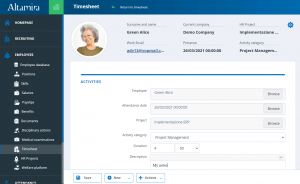We have talked before about employee retention and about all the mistakes that a company must avoid if it wants to hold on to its wealth of human resources.
However, no matter how much effort a company makes in this regard, it is inevitable that sooner or later, an unhappy employee will begin to consider the possibility of finding another job. In such cases, the only way to retain a valuable human resource is to catch the signs of their discontent in time, and take action as soon as possible to solve the problems that are pushing them towards leaving the company.
At first glance, the best signs that allow us to know that an employee is unsatisfied are behavioral ones.
Some of these are: suddenly dressing more formal than usual (perhaps in view of a job interview), an increase in the number of personal calls, a certain detachment towards work issues that used to interest them, trying to evade making long-term commitments, etc.
It must be emphasized, however, that these signs can be easily identified only by close coworkers and managers of small teams, and that in the absence of other more concrete sources of information, an employee’s resignation can come as a bolt from the blue for the Human Resources department and for the managers who would be most affected by it.
However, if the management of HR processes is digitized, the managers and the HR department can count on a large quantity of data and reports—which, furthermore, are objective and can be tracked automatically—to identify any significant decrease in an employee’s level of engagement and motivation.
Let’s look at some of this data.
Abnormalities in clocking in/out
Companies using modern attendance monitoring software have a valuable indicator at their disposal to detect any changes in the behavior of an employee.
Sudden and frequent lateness, errors and omissions in clocking in and out, the failure to send timely requests for leave, etc., all generate anomalies in the system that need to be resolved, and can easily set off alarm bells.
Drops in evaluation results
One of the advantages of a digitalized employee evaluation system is the possibility of easily identifying not only declines in performance—simply put, the failure to achieve a goal—but also the level of active participation in the process. An employee who suddenly stops being proactive and no longer gets the results they previously did might have “given up” and be planning to change jobs.
Lack of participation in corporate training
A self-service platform for organizing corporate training gives great autonomy to employees and allows you to identify those who are most interested in self-development.
A drastic drop in course enrollment, seminar attendance and/or grades may indicate a loss of interest in pursuing a career path within the company.
No longer working overtime
Has an employee who used to stay at the office well after the normal working hours suddenly stopped working overtime and putting in overtime requests?
This could also be a sign of a loss of interest towards the work they do at the company, which often comes before their resignation.
An increase in requests for leave and holidays
There is nothing wrong with an employee who wants to take some well-deserved time off or a vacation. But a sudden increase in such requests, if concentrated in a certain period of time and always sent on short notice, may be a signal that needs following up, if only to ensure that the employee isn’t going through some personal problems with which the company can help in some way.
Of course, such changes in an employee’s attitude and approach to work can come from a variety of causes. The important thing is to spot them, which gives you a reason for having a chat with the employee to find out if there is something amiss.
Copyright: ©adrian_ilie825/Fotolia.




























































































